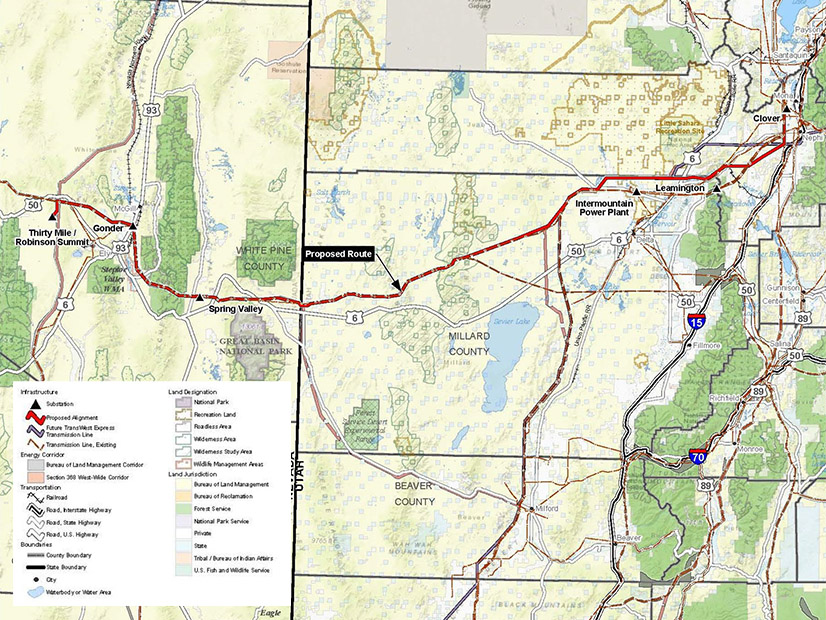
The proposed Cross-Tie transmission project is moving through the federal approval process with a targeted in-service date in 2027.
The proposed Cross-Tie transmission project — a 214-mile line across Utah and Nevada that’s seen as a missing link in the Western transmission system — is moving through the federal approval process with a targeted in-service date in 2027.
TransCanyon LLC has proposed the 500-kV HVAC line connecting PacifiCorp’s Clover substation in Utah with NV Energy’s Robinson Summit substation in Nevada.
The U.S. Bureau of Land Management, the lead federal agency for the project, released a draft environmental impact statement for the proposal last month. BLM expects to decide in 2024 whether to grant the developer’s right-of-way request.
TransCanyon is a joint venture between Berkshire Hathaway Energy’s BHE U.S. Transmission and Pinnacle West Capital, the parent company of Arizona Public Service (APS).
The 1,500-MW Cross-Tie transmission project will cost an estimated $750 million and is expected to begin service in 2027, according to TransCanyon’s website. TransCanyon plans to develop, own and operate the transmission facilities.
Delivering Renewables
TransCanyon called Cross-Tie a “missing pathway” in the Western transmission system that would enhance resilience and reliability and boost the delivery of renewable energy.
At its eastern end, Cross-Tie would connect to the southern tip of PacifiCorp’s 416-mile Gateway South transmission line, which runs across Wyoming, Colorado and Utah.
At Cross-Tie’s western end is the Robinson Summit substation, the northeastern vertex of NV Energy’s planned transmission triangle around Nevada. The triangle consists of the proposed Greenlink North and Greenlink West lines and the existing One Nevada Line.
TransCanyon said that Cross-Tie, in concert with PacifiCorp’s Energy Gateway projects, the Greenlink projects and the Harry Allen-to-Eldorado project in southern Nevada, would provide needed transmission capacity between the Intermountain West and the Desert Southwest.
“This additional transmission capacity would facilitate access between the significant existing and planned renewable resources, primarily wind in Wyoming and wind or solar resources in central Utah and eastern Nevada, to the diverse utility load profiles in the Desert Southwest/California,” TransCanyon said in a development plan submitted to the BLM.
In addition, Cross-Tie might reduce solar curtailments and battery storage needs in California and the Desert Southwest, the plan said.
During a virtual public meeting hosted by BLM on Dec. 5, one attendee asked whether any contracts are in place that would guarantee Cross-Tie will deliver renewable energy.
TransCanyon representative Roger Yensen said the developer plans to complete the environmental review process with BLM before entering into contracts.
But given its strategic location, Yensen said, “we anticipate there will be a significant portion of energy that will be carried on the Cross-Tie [project] that will be from renewable resources.”
In October, the U.S. Department of Energy announced it would become an anchor off-taker for three interstate transmission projects, including Cross-Tie. (See DOE to Sign up as Off-taker for 3 Transmission Projects.) Yensen said negotiations with DOE are underway.
TransCanyon isn’t currently planning to connect Cross-Tie to the Intermountain Power Plant in Utah, even though the transmission project’s path runs near the facility. But that could be considered in the future, according to the development plan.
Alternative Routes
In its environmental review of Cross-Tie, BLM is examining the developer’s proposed transmission path as well as several alternatives that would add four miles to about 150 miles to the route. BLM staff said the transmission project will cost roughly $3.5 million per mile.
One alternative route addresses concerns from the town of Leamington, Utah, about the project’s impacts on scenic views.
“Why would any project be proposed that destroys the view the residents of Leamington have enjoyed and cherished for over 150 years when a viable alternative is readily available?” Leamington’s mayor said in a written comment submitted for the virtual meeting.
Other alternatives were designed to reduce impacts to cultural resources, environmentally sensitive areas or the U.S. Department of Defense’s Utah Test and Training Range. BLM has not yet selected a preferred alternative.
In addition to the virtual public meeting, BLM held four in-person meetings on Cross-Tie in late November.
The deadline to comment on the draft environmental impact statement is Jan. 2.
